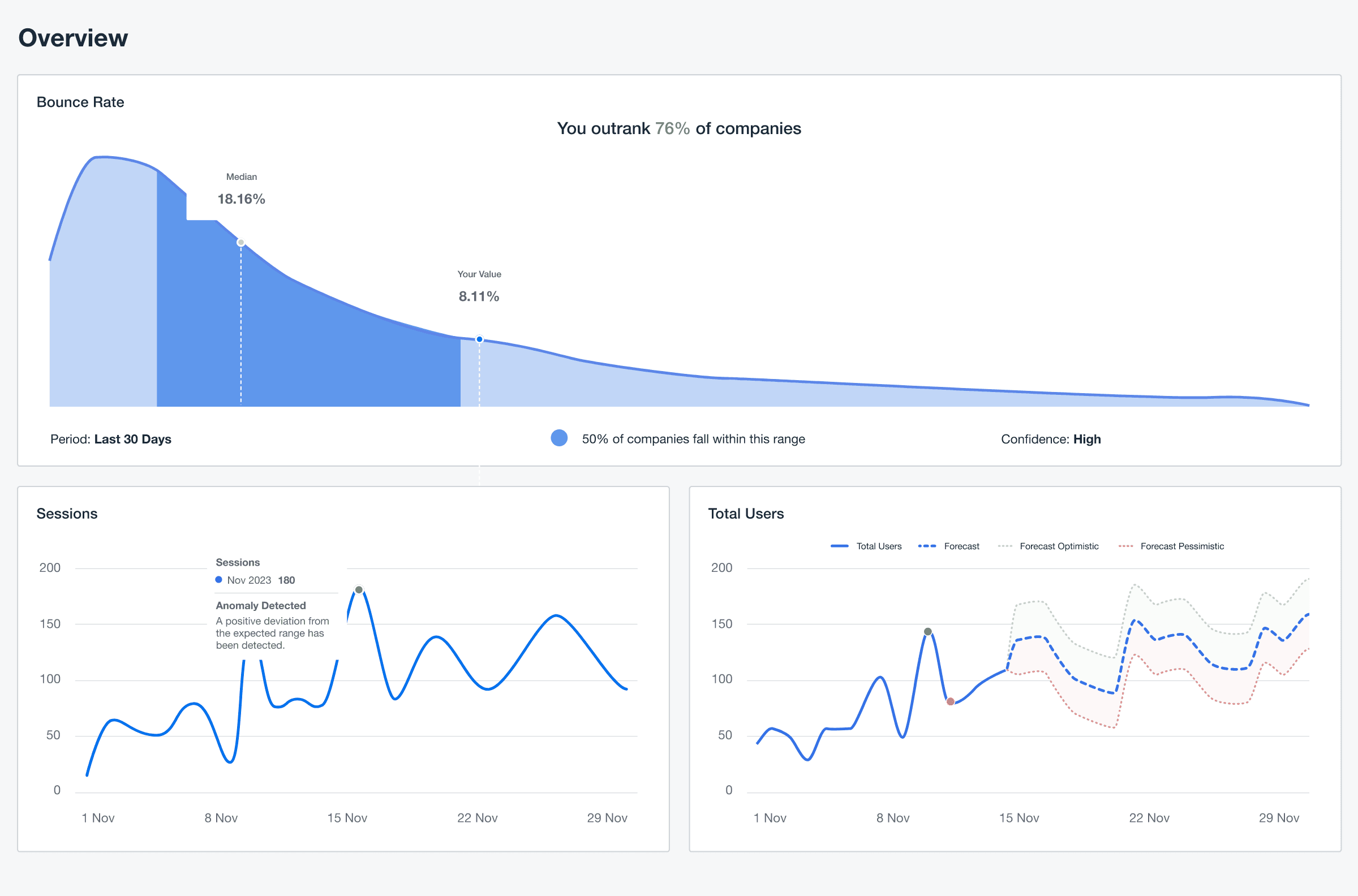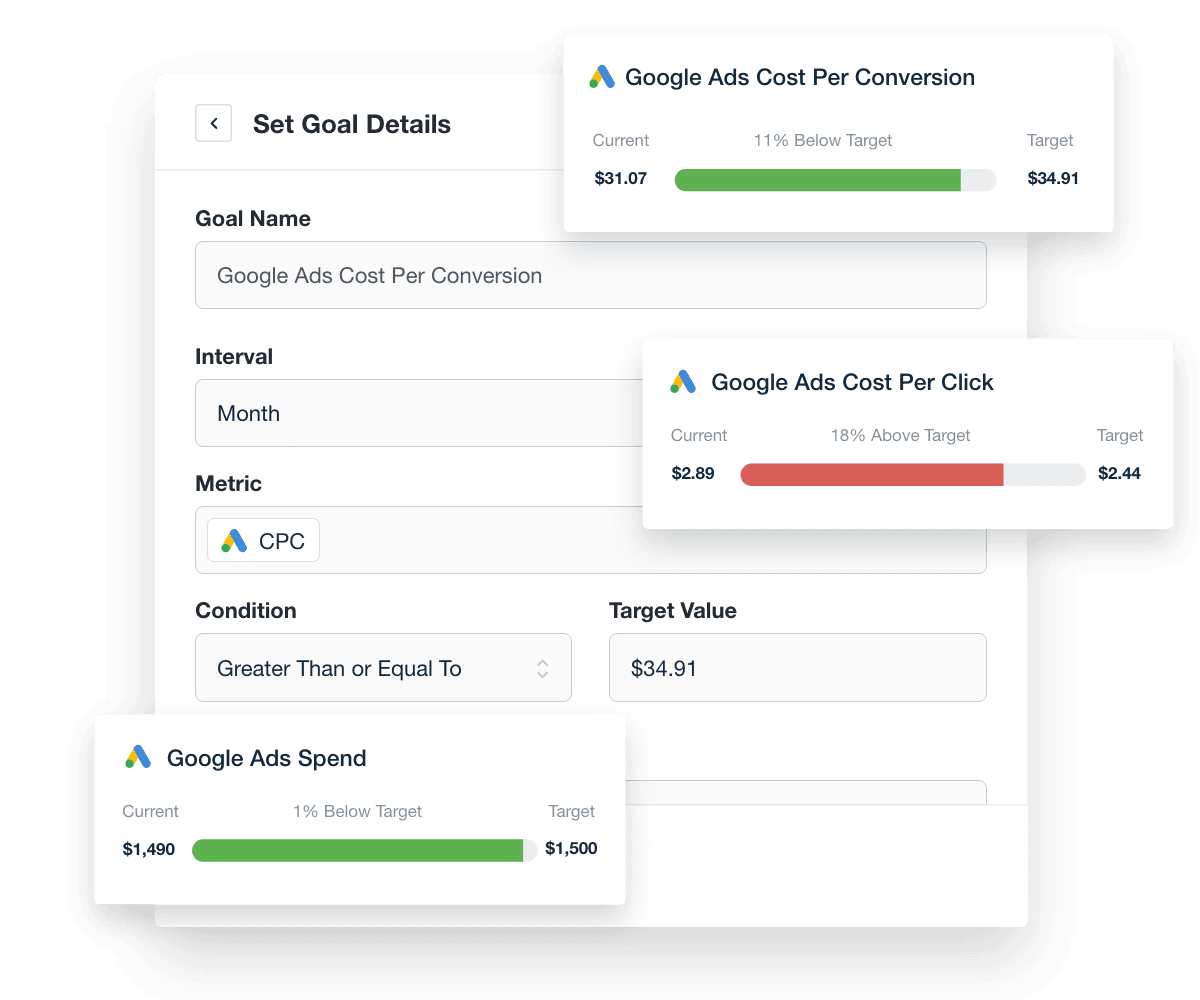Hit targets with automated campaign goal tracking and budget pacing

Show clients how you’re helping them win
Clients stick with agencies that show results. Monitor the metrics that matter most to your clients, spotlight significant achievements, stay on budget, and seamlessly present this information in your automated marketing reports and custom dashboards.
Track Progress
Create goals and visually display how you’re progressing towards them
Report Transparently
Add goals that make sense for your client to your reports and custom dashboards
Manage Budgets
Keep your clients’ budget pacing on track and in line using goals
Retain Clients
Prove the value your marketing agency brings to the table
Set Goals and Achieve Performance Targets
Clients need a clear way to see how you're driving progress toward their goals. Drag and drop goal tracking into reports and dashboards, visually track key metrics as they move toward targets, and provide instant visibility into campaign performance—so clients see the impact of your work at a glance.
Set Client-Specific Goals That Prove Your Agency’s Impact
Your clients’ KPIs are as unique as they are. Create your own formula with custom metrics to visualize how your agency is performing against your clients’ custom goals. The Goals feature automatically calculates your progress to report if each goal is on or off track. Easily measure against targets to showcase your success in a visual way.
Track Monthly, Quarterly & Annual Results All in One Place
Stay on top of every client’s performance without switching views. Compare monthly, quarterly, and annual goals in a single snapshot to instantly identify wins, spot trends, and guide strategy updates that keep campaigns ahead of target.
Leverage Goal-Driven Budget Pacing
Maximize your marketing impact by using the Goals feature to manage budget pacing. Set, track, and adjust your spending goals in real-time to ensure optimal ROI and client satisfaction. Keep your campaigns financially focused and efficient, preventing budget overruns with precision and ease.
Monitor Performance Across Clients & Locations
Easily filter and view your agency’s goals across client groups you've created to see your performance for multiple locations, brands, or clients—all in a single view. Want to see goals for a specific client? Simply click that client name or navigate to that client for a customized view of how you're progressing toward your related goals.
Tell a Success Story With Your Clients’ Data
Storytelling with client data is crucial for impactful reporting. Including tracked goals paints a vivid picture of progress and success, demonstrating the tangible value clients receive from their investments. Keep clients well-informed, building lasting trust, and reinforce the effectiveness of your agency's efforts.
Set Campaign Targets That Match Your Client’s Strategy
Whether you're tracking ongoing performance, managing a time-bound campaign, or hitting a firm deadline, choose between recurring and one-time goals—complete with custom start and end dates to match your strategy.


FAQs About Marketing Campaign Goal & Budget Tracking
Looking to keep client campaigns on track and within budget? These FAQs explain how goal tracking dashboards help agencies monitor performance, drive growth, and deliver clear results.
Marketing campaign goal tracking is the process of measuring progress toward key objectives—like website traffic, conversion rates, or campaign performance—using predefined targets. A goal tracking dashboard helps marketing teams visualize how current campaigns are performing and adjust strategies as needed.
The best way is using a centralized goal tracking dashboard that pulls campaign data from different platforms and presents actionable insights in one view. With AgencyAnalytics, marketing agencies monitor current campaigns, compare performance across channels, and align efforts with business objectives in real time.
A goal tracking dashboard helps agencies visualize campaign effectiveness, identify underperforming areas, and drive growth. It reinforces client confidence by providing transparent insights into marketing campaign results, budget spend, conversion rates, and user behavior—all tailored to your client's needs.
Goal tracking dashboards help agencies refine marketing strategies by highlighting which marketing channels, tactics, and data points led to success in a particular campaign. By analyzing this performance data, agencies gain the insights needed to optimize future campaigns and make smarter, data-driven decisions across all client accounts.
Goal tracking is includes with AgencyAnalytics premium plans starting at $349 per month. For agencies, the time saved by automating campaign goal tracking—and the retention boost from delivering professional tracking dashboards—makes it a valuable investment.
Choose marketing goal tracking software that integrates with multiple platforms, simplifies data collection, and presents goal tracking in a user-friendly dashboard. AgencyAnalytics makes it easy to set targets, track marketing goals seamlessly, and keep clients engaged with your agency's services—all while linking goal performance to budgets. Try it free for 14 days and see how easy it is to drive measurable growth.
More features

Marketing Performance Insights

Database Connectors

Forecasting Tools

Anomaly Detection

Data Visualization
Client Portals
See how 7,000+ marketing agencies help clients win
Free 14-day trial. No credit card required.




